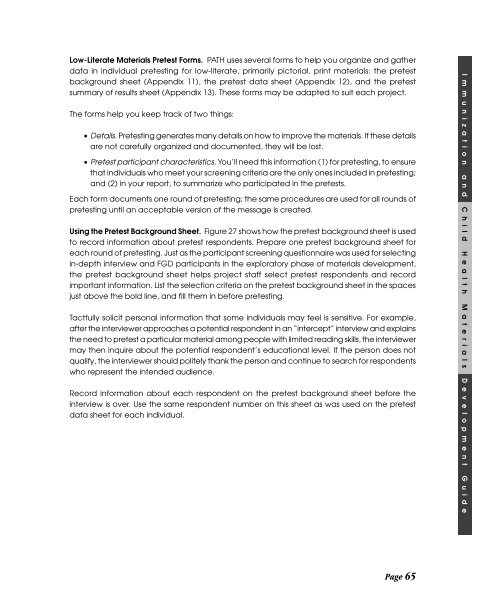Immunization and child health materials development guide pdf
Immunization and child health materials development guide pdf
Immunization and child health materials development guide pdf
You also want an ePaper? Increase the reach of your titles
YUMPU automatically turns print PDFs into web optimized ePapers that Google loves.
Low-Literate Materials Pretest Forms. PATH uses several forms to help you organize <strong>and</strong> gather<br />
data in individual pretesting for low-literate, primarily pictorial, print <strong>materials</strong>: the pretest<br />
background sheet (Appendix 11), the pretest data sheet (Appendix 12), <strong>and</strong> the pretest<br />
summary of results sheet (Appendix 13). These forms may be adapted to suit each project.<br />
The forms help you keep track of two things:<br />
• Details. Pretesting generates many details on how to improve the <strong>materials</strong>. If these details<br />
are not carefully organized <strong>and</strong> documented, they will be lost.<br />
• Pretest participant characteristics. You’ll need this information (1) for pretesting, to ensure<br />
that individuals who meet your screening criteria are the only ones included in pretesting;<br />
<strong>and</strong> (2) in your report, to summarize who participated in the pretests.<br />
Each form documents one round of pretesting; the same procedures are used for all rounds of<br />
pretesting until an acceptable version of the message is created.<br />
Using the Pretest Background Sheet. Figure 27 shows how the pretest background sheet is used<br />
to record information about pretest respondents. Prepare one pretest background sheet for<br />
each round of pretesting. Just as the participant screening questionnaire was used for selecting<br />
in-depth interview <strong>and</strong> FGD participants in the exploratory phase of <strong>materials</strong> <strong>development</strong>,<br />
the pretest background sheet helps project staff select pretest respondents <strong>and</strong> record<br />
important information. List the selection criteria on the pretest background sheet in the spaces<br />
just above the bold line, <strong>and</strong> fill them in before pretesting.<br />
Tactfully solicit personal information that some individuals may feel is sensitive. For example,<br />
after the interviewer approaches a potential respondent in an “intercept” interview <strong>and</strong> explains<br />
the need to pretest a particular material among people with limited reading skills, the interviewer<br />
may then inquire about the potential respondent’s educational level. If the person does not<br />
qualify, the interviewer should politely thank the person <strong>and</strong> continue to search for respondents<br />
who represent the intended audience.<br />
Record information about each respondent on the pretest background sheet before the<br />
interview is over. Use the same respondent number on this sheet as was used on the pretest<br />
data sheet for each individual.<br />
Page 65

















